
MANUFACTURER'S SPECIFICATIONS
Frequency Response: Std. tape, 40 to 12,000 Hz; CrO2 tape, 40 to 13,000 Hz.
S/N Ratio: 48 dB, std. tape; 58 dB w/Dolby; 4.5 dB improvement with CrO2 tape.
Harmonic Distortion: Less than 2% for 333 Hz at 0 VU.
Input Sensitivity: Line, 60 mV at 470 kOhms; mike, 0.2 mV at 20 kOhms.
Output Level: Line, 300 mV; phones, 40 mV into 8 ohms.
Wow & Flutter: 0.1% W rms.
Fast Forward and Rewind Time: 80 sec., C-60.
Dimensions: 17 in. W x 5 1/2 H x 12 ½ in. D.
Weight: 18.8 lbs.
Price: $369.95.
The Pioneer CT-F7171 cassette recorder has been on the market for a while and is one of the earliest of the growing group of front-load units. The opening for insertion and removal of cassettes is at the left of the front panel. The tape drive mechanism is inclined at an angle within the opening to facilitate inserting cassettes. A spring-loaded tray receives the cassette and then latches down in playing position.
When released the cassette is ejected onto an inclined shelf at the bottom of the opening. The Memory On-Off switch is on the front panel to the left, with the counter and its reset button just inside. An interior convenience light for observing tape motion and cleaning heads, has its lever switch on the front panel to the right. A transparent plastic door can be let down to cover the drive mechanism for dust protection.
Below the cassette-access opening and to the left is the Power On-Off switch. Next to the right is the spring-loaded push-to-operate Skip button, which advances the tape at twice normal speed in Play for cue purposes. Then there is a series of levers to control Record, Rewind, Play, Fast Forward, Pause and Stop/Reject. Next is the button that releases the door to drop down in front of the cassette well. The door snaps into a retaining latch when pushed upward.
The level meters on the right side of the front panel are of good size and well illuminated. The scale markings are very legible and are noticeably expanded above 0 VU, an aid to detecting excessive record levels. Between the two meters are the Record and Peak indicator lights. Located below the meters are a row of four button switches for Dolby NR, Tape Bias and Equalization, and Record Limiter. With the Bias switch, selection can be made for Normal or Chrome tapes.
Equalization can be set for normal tape (and older chrome) or for the new 70-microsecond chrome. The Input (record) and Output (play) level pots are identical in construction, with knobs for each channel mounted on concentric shafts.
Friction between the sections allows the levels to be adjusted individually or simultaneously, as desired. A plastic ring with a red indicator line located behind each set of pots provides a level reference.
There are three phone jacks at the very right of the front panel-two for microphones and one for stereo headphones. Plugging into the microphone jacks disconnects the associated line inputs. On the rear panel are the input and output phono jacks, paired to facilitate connection to other equipment. A DIN socket provides input/output connections for systems with DIN plugs. The back panel also includes a ground terminal, an a.c. convenience outlet (un switched) and the fuseholder.
With the top cover removed the electronic assemblies are visible. At the top left is a small board with three fuses, which indicates unusual attention to protection of the system components. One 500 mA fuse is in series with the pilot lamps in the meters, an 800 mA fuse protects the B+ line, and a one-amp fuse is in series with the unswitched a.c. convenience outlet on the rear panel.
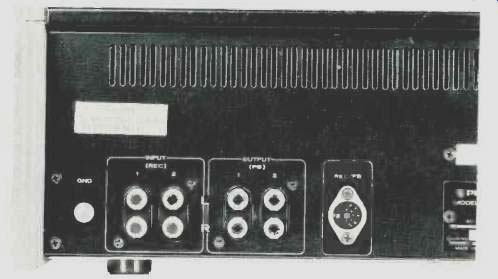
Fig. 1--Rear panel of Pioneer CT-F7171 deck.
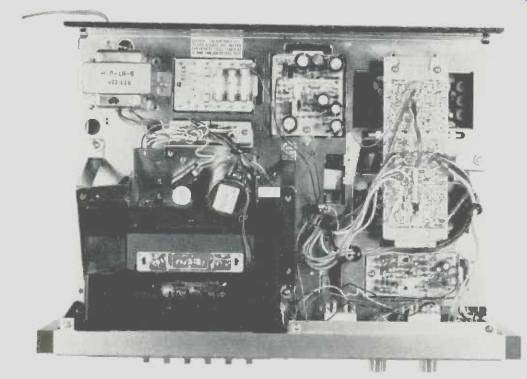
Fig. 2--Inside view of cassette deck with top cover removed.
Performance

Fig. 3--Record/Playback response, Maxell UD tape, with and without Dolby,
recorded at Zero VU and at-20 VU.
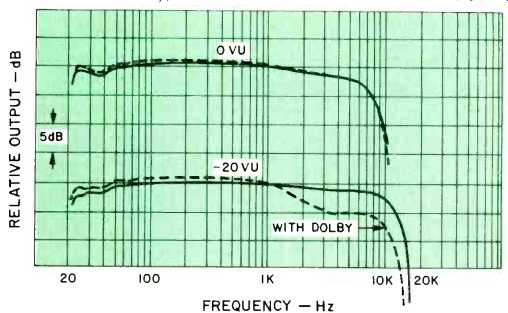
Fig. 4--Record/Playback response, TDK KR (chromium dioxide) tape, with
and without Dolby, recorded at Zero VU and at -20 VU.
Response from standard tapes was tested first, and playback response from a standard DIN tape was within 2 dB to over 4 kHz, 5 dB down at 10 kHz. With the CrO2 test tape, the response was within 2 dB to 10 kHz, 5 dB down at 12.5 kHz. The channel B record/playback response was the better of the two and is reported here. Good results were obtained with Maxell UD, which provided very flat response and 3-dB down points at 30 Hz and 12.7 kHz at the -20 VU level without Dolby, superior to Pioneer's specs. The-20 VU response with Dolby was also very close, indicating excellent tracking of the Dolby circuits with the flat-response inputs. Results with Memorex MRX2 and Capitol Music tape were also quite good, while the deck showed some high-frequency droop with other tapes. The CT-F7171 reached 10.8 kHz with TDK KR, the better of two chrome tapes tested. With Dolby On, at -20 VU with this same tape, response was 7 dB down at 10 kHz.
A spectrum analyzer was used to measure distortion generated by a 1-kHz signal at record levels from-1 to +10 VU. Distortion was commendably low with the low-noise tapes, which averaged 0.20 percent at 0 VU without Dolby, and 0.14 percent with Dolby. Distortion with the chrome tapes averaged 0.85 and 0.50 percent. With Memorex MRX2 the distortion was a very low 0.06 percent at 0 VU, 0.05 percent with Dolby. The 2 percent distortion reference was not exceeded with a number of the low-noise tapes until approximately +10 VU. The chrome tapes showed 2 percent distortion at about +5 VU. See Fig. 6.
Minimum distortion over a range of frequencies from 30 Hz to 10 kHz was at 500 or 1000 Hz, and depended on the tape type. At 10 kHz, careful analysis proved that the high-level "harmonic" was actually a beat note between the eighth harmonic of the test tone and the bias oscillator. The average signal-to-noise ratio for three low-noise tapes was very close to 48 dBA (A-weighted) which is as specified. With a two percent distortion reference, the average was 57 dBA. With Dolby On, the averages for all low-noise tapes were 55 dBA at 0 VU and 65 dBA at 2 percent distortion. With the two chrome tapes the results were slightly better at 0 VU, but slightly worse at 2 percent distortion.
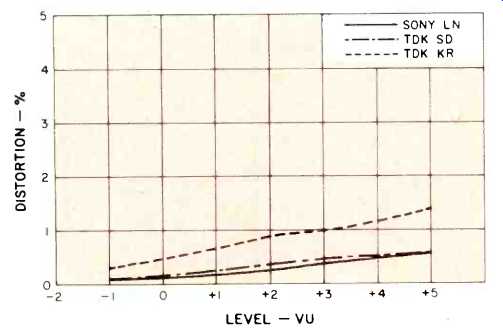
Fig. 5--Harmonic distortion at 1 kHz, three tapes, with Dolby noise reduction.
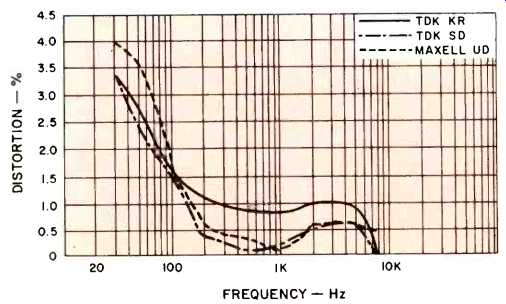
Fig. 6--Distortion versus frequency for three tapes.
A 1000-Hz tone at 0 VU was erased to at least 72 dB down. Cross-talk from channel to channel was -41 dB, quite satisfactory. Crosstalk to the channel of opposite-play direction was at least 70 dB down. The lowest flutter was 0.06%, with an average of 0.19%, both for DIN-weighted peak. These figures would be approximately 0.03% and 0.09% on A-weighted rms basis and thus within the specified 0.1%. Average rewind time for 77 seconds, better than the 80 seconds specified. Tape speed was slightly high, 2.0% fast, but was very consistent, regardless of changes in the line voltage.
At 0 VU the output to headphones was 450 mV across 8 ohms, much greater than the specified 40 mV. Microphone input sensitivity was 0.19 mV and line sensitivity was 50 mV, both better than stated. The limiter showed its effect above 0 VU and reduced a 20-dB increase in the input to just +4 VU. Response time was about 20 milliseconds.
The output at 0 VU is specified at 300 mV. In record, it measured 315 mV. Some of the tapes tested met this level in playback, although the standard level on the DIN test tape indicated +3 VU. Testing with tone bursts of varied duration showed the meter response close to the VU standard, which many do not. The peak indicator began to flash when fed a 10-millisecond burst at a +4 VU level.
In-Use Tests
The front-loading scheme is well designed in its basic components, with easy loading and smooth ejecting. Demagnetizing and cleaning the heads, as well as head alignment, is somewhat difficult. Ejecting a cassette while the door was down, admittedly an improper action, but nevertheless something a new owner might easily do until he became familiar with the machine, required a bit of care to clear. Tape drive controls were well interlocked, but the Record lever required more force to actuate than seemed convenient. The front panel has a nice, subdued look, a plus factor for some people. The Dolby indicator is relatively small, and the operator should remember to be certain of the status of the tape type switches. The level pots worked very well in controlling both channels simultaneously, but the high friction between sections made initial balancing difficult. On the other hand, the reference level rings were looser, allowing them to be moved more easily.
The instruction book provides all details required for using the deck, and the schematic is quite acceptable. Access to the interior is gained by removal of just four screws holding the top enclosure. The bottom is shielded and protected by a rigid metal plate. Construction is of good quality with helpful labels on the circuit cards.
Listening tests were performed by copying portions of Walter Carlos' Switched-on Bach and a Haydn Sinfonia Concertante. A minor difficulty experienced was that the peak indicator was hard to see until the ambient light level was reduced. The CT-F7171 provided very satisfactory listening on playback with Maxell UD, both with and without Dolby, the lower-noise Dolby version being slightly better. Memorex MRX2 and Capitol Music Tape showed up very nearly as well, with a slight loss of brightness with Dolby. The poorer high-frequency response on channel A was probably the cause of a subtle deterioration of the stereo effect. The treble loss with chrome tapes caused their playback to be relatively duller, with strong apparent bass. It appears possible that this machine could be adjusted for optimum response with the various chrome formulations, though the user might not wish to have this done. We obtained best performance with Maxell UD, Memorex MRX2, and Capitol Music Tape.
-Howard A. Roberson
(Adapted from: Audio magazine, Nov. 1975)
Also see:
Pioneer Model T-600 Stereo Tape Deck (Equip. Profile, Mar. 1970)
Pioneer tape decks (ad, May 1975)
= = = =